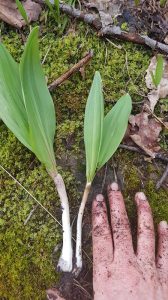
Have you used an “allium” in your cooking today, I’ll bet you have, they are a vegetable family consisting of garlic, shallots, scallions, chives and leeks. Wild leeks are known as “ramps”. Northern Ontario wild leeks, ramps, are some of the world’s best. They are one of the very first gifts of spring to us, before fiddleheads, before morels and before asparagus, ramps already urging us to a harvest. Like the other springtime delights, ramps are available for a very limited time, you’ll want to harvest them before they flower, these “little stinkers” maybe heavy on the garlic aroma, but they are fantastic in the flavour department.
After winter has departed our bodies are crying out for some time of refreshing, ramps can help in doing this, they actually assist in the detoxification of the body, cleansing out what may be harmful to us. They are rich in nutrients nd sulfurous compounds that our bodies need to recover from winter’s lethargy. Along with the sulfur compound ramps provide vitamin C, potassium, and iron, along with flavonoids and fiber, all of which energises the body, providing us with anti-inflammatory and anti-cancer properties. Or, you may need relief from spring time allergies and hay fever, ramps contain quercetin, an antioxidant that acts as an anti-histamine.
Ramps are entirely edible, leaves, stems and bulbs are ready for your culinary creations, after they have been thoroughly cleansed. You may use ramps anyway or any where you use onions, garlic, etc.
Use fresh, of course, but if you want the wonderful additions of ramps flavour later on in the year you’ll have to think on ways to preserve them, you may blanch them, after cleaning them, dip them into boiling salted water for 2 minutes, then into a ice water bath, remove abd allow to dry, then freeze in air tight freezer bags, or, better yet make a ramp pesto, a tablespoon of that will a long way (recipe follows).
RAMP PESTO
2 cups ramp leaves and stems, about 2 dozen
3 ramp bulbs (garlic clove size)
1/4 cup toasted pine nuts or filberts
3 tablespoons grated cheese, such as pecorino
About 1/2 cup extra-virgin olive oil
Salt to taste
Instructions
Chop the blanched ramps and place into a food processor along with the bulbs, nuts and cheese .
With the machines running on low, slowly pour the oil in, process until thick, adjust the taste with salt and pepper, or a little more cheese.
Pack in small satirized canning jars, seal and then freeze.
Ramps are harvested in forests here in Canada, and in the upper Midwest, mid-Atlantic and northeastern United States. These are wild sustainable products so care must be taken during the harvesting process. They take their time in growing (2 years to mature) so the careful harvester will pick the stems and leaves, attempting to leave the blubs, it’s the blubs that breed so you want to leave as many as possible.
Using the greens leaves in cooking is great of course, but try using the white stems to infuse homemade vinegars, apple cider, or pineapple. We juice a lot of pineapple, then use the remaining pulp to make delicious pineapple vinegar. Once aged by 6 weeks we place the cleansed ramps stems in the sterilized bottles, seal and set aside in a dark place for another 4 weeks to mature, then, boom, you have a delicious condiment to use to flavour, anything from marinates, salsa’s, soups, salads, fish or meats.
PINEAPPLE VINEGAR
NGREDIENTS
6 cups water
3⁄4 cup dark brown sugar
4 cups fresh pineapple, chopped (pulp and the peel and trimmings)
4 Large coffee filters
Rubber band
DIRECTIONS
Wash jar and lid well.
Add water and brown sugar to jar. Stir well to dissolve sugar.
Add pineapple peel and trimmings. Stir well.
Cover jar with coffee filters then use the rubber band to hold them in place while the mixture ferments.
Set aside in warm, dark place for 4-6 weeks. Leave alone.
The liquid may turn murky and brown, but the solids will settle and the color will clear.
When the liquid is clear, strain out the solids by pouring the liquid through several layers of cheesecloth.
Pack clean sterilized bottles with ramps, pour the vinegar, seal.
Store vinegar in a clean bottle, away from light.
NOTE: Mother knows best, while storing, the vinegar will form a gelatinous mass that floats or sits at the bottom of the jar. It’s the mother of the vinegar, it’s totally harmless in fact you want it. Use it when making additional batches or use it as a major part of the vinegar.